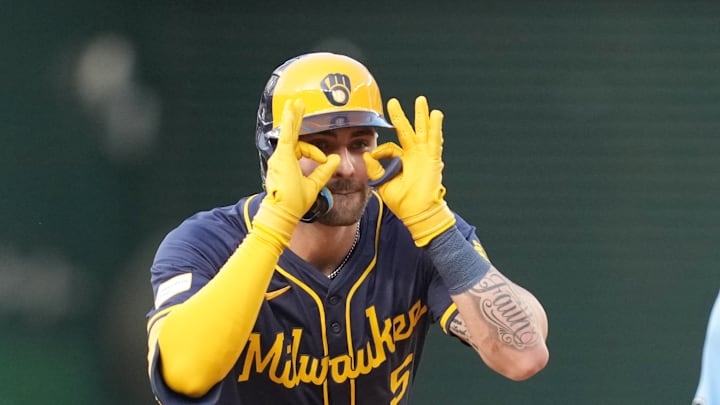The Brewers are not cruising effortlessly through the middle of the 2024 season. Since July 1, they are a modest 12-15, having followed a 2-4 home stand with losses in two of three games in Washington.
As a consequence, while the Brewers remain firmly in command in the NL Central for the moment, their long-term prospects are, at least slightly, more questionable. The reason: One of their division competitors has begun to suggest the ability to overtake them.
Despite their sub-.500 record over the past five weeks, the Brewers have seen just a half game shaved off their divisional advantage. They led the Cardinals by 6.5 games entering play July 1; they lead the Cardinals by 6.0 games entering play Aug. 6.
But that slowed pace of performance has allowed one team to build enough momentum to make a serious run at the Crew and it’s not the Cardinals but the Pittsburgh Pirates.
Here’s a look at how the Brewers’ post-season prospects measure versus their divisional competitors approaching the final one-third of the 2024 season.
Schedule strength
The five NL Central teams have between 48 (Cubs) and 51 (Brewers, Pirates, Reds) games remaining. Schedule strength works slightly in favor of the Brewers since the only one of their divisional rivals whose opponents have a cumulative sub-.500 record is the Cubs, back in fourth place.
It also helps that the current runner-up Cardinals have the toughest remaining schedule, their 50 foes averaging an imposing .521 winning percentage. The Brewers, Pirates and Reds all face teams with cumulative winning percentages around .510.
The Brewers do have a six-game home-and-home yet to be played with the Cardinals, the best opportunity or the Cards to catch up or for the Crew to bury their closest rivals. The Pirates have the most head-to-head opportunities with 20 games still on the schedule against NL Central teams.
Offense
Statistically the Brewers have the division’s best offense, ranking sixth in the NL in OPS, fifth in runs per game and eighth in slugging. Those figures are all superior to all of their division rivals.
The problem is that the offense has tailed off in recent weeks following Christian Yelich's injury. For the season as a whole the Brewers are averaging 4.7 runs per game, but since July 1 that average has fallen to 4.4. That’s not condemnatory, but it is a concern.
And it’s a particular concern because one divisional rival – the Pirates – seems to have found its offense. Since July 1, Pittsburgh has average 4.8 runs per game, significantly above its 4.12 season-long average. So the Pirates are scoring at precisely the moment when the Crew’s offensive pace has slowed.
Pitching and defense
Milwaukee’s pitching has also slumped through the dog days. Since July 1 the Brewers are allowing 4.3 runs per game, compared with 4.01 for the season as a whole.
And again one team – the Pirates – has improved it pitching dramatically as the Brewers’ staff has waned. Pittsburgh is averaging 4.58 runs allowed per game for the season as a whole, but that allowance is down more than half run – to 3.8 – since July 1. So in pitching as well as offense, the third place Pirates have become a team of concern.
Defensively the Crew remains elite. Milwaukee leads the National League in Defensive Runs Saved (+38), a healthy measure above the Cardinals (+25). Defense has been a weakness for the Pirates, who rank 12th in the NL at -7 Defensive Runs Saved.
Projected finish
Putting all that together, it is the third place Pirates rather than the runner-up Cardinals showing the recent form to threaten Milwaukee’s current edge.
The Brewers are just 12-15 since July 1, a pedestrian .440 winning percentage. The Pirates are 29-22 over that same span, a .571 run. Is Pittsburgh gaining quickly enough to catch Milwaukee?
Here’s a look at the winning percentages of the five divisional teams in three phases: Right now, since July 1, and projecting to season’s end presuming teams continue to play at their post-July 1 pace.
Now Since July 1 Proj. Oct. 1
Milwaukee .559 .444 .519
St. Louis .509 .483 .500
Pittsburgh .505 .571 .525
Chicago .482 .552 .506
Cincinnati .477 .519 .488
These projections do presume something not necessarily in evidence, namely that teams will continue to do what they have recently been doing. But it does serve the purpose of illustrating two things: how ill-prepared the Brewers’ closest challenger (St. Louis) is to catch up), and well-positioned the Pirates are to make that run. They have all that good young pitching, they have 13 games remaining versus the Cubs and Reds, and if they can get close they have three final week games against the Brewers in Pittsburgh.
In short, the Crew needs to return to its consistent pre-July form or risk allowing an improving Pittsburgh team to close in.
